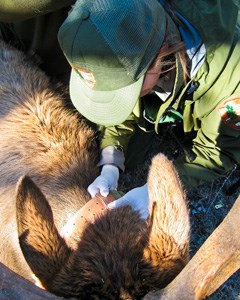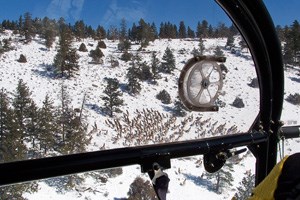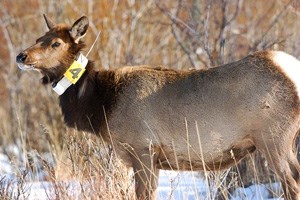
NPS
Ongoing research continues to find connections between elk and vegetation processes. Scientists are learning more about additional factors that influence the park's elk population.

NPS A number of female elk from Rocky Mountain National park and the Front Range have been fitted with colored radio collars. Various interagency research studies currently use this scientific tool to gain information about migration, survival, disease and habitat use among the elk population. Many collars last 5-10 years and provide critical information throughout the life of the animal. Chronic Wasting Disease Research on chronic wasting disease (CWD) primarily focuses on monitoring disease prevalence in the park's living elk. See the chronic wasting disease page to learn how this disease affects elk. Here are some quick facts:
Fertility Control Researchers studied a fertility control agent that could be used to maintain or reduce elk numbers in the future. This multi-season study was possible because researchers tested elk already designated for culling during the 2008-2011 winter seasons. Researchers evaluated the duration and side-effects of GonaCon Immunocontraceptive Vaccine (GonaCon) on 60 collared female elk (Powers et al. 2014). Results indicated that GonaCon was effective the first year, as none of the treated animals became pregnant. It became less effective over time as more than half of treated females became pregnant by the third year. The primary side effect was localized inflammation at the injection site. GonaCon is not registered for widespread federal and state use in elk. Further research is needed to determine if fertility control can be applied effectively to a large free-range elk population. Park staff are currently not using fertility control as a tool to manage the population. 
NPS Population Monitoring Research was conducted to improve elk monitoring methods and the accuracy of elk population estimates. Combined aerial helicopter and fixed-wing surveys with multiple observers were conducted during the winters of 2007-2010 to test double-count protocols and collect data to better assess the probability of missing elk during aerial surveys. Elk location data collected from GPS radio collars placed on 14 elk were used to provide a better understanding of elk distribution and to define a more efficient survey area. When researchers applied this new method, results projected that between 84 and 97 percent of elk were seen by observers during aerial surveys (Schoenecker et al. 2013). Telemetry data also confirmed that elk movements are highly dynamic across the park boundary, suggesting the need for multiple surveys throughout the winter. High costs and difficult conditions limit the number of aerial surveys that can be done, so on-going research is using simultaneous ground and aerial surveys. Calibrated ground counts can be conducted frequently with sightability-corrected aerial counts. 
NPS/Rob Stuehrk Population Modeling Ongoing work continues to improve the population model that uses the sightability corrected count data to estimate the elk population size and predict what could be expected under different management scenarios. Telemetry location data are used to determine the proportion of time that elk which move across the park boundary spend inside the park (Hobbs 2013). This information along with ground survey results will be incorporated into the model to more accurately assess average elk use of the winter range. Redistribution Elk redistribution can be used to modify elk behavior and decrease elk densities in critical areas of the core winter range. The purpose is to trigger an escape response that scatters elk and encourages them to stay away from sensitive willow and aspen areas. Researchers conducted a literature review of redistribution methods from numerous research studies (Walter et al. 2010). The review suggested redistribution techniques that might work best to meet the objectives of the Elk and Vegetation Management Plan and could be used experimentally in the future as needed. These included herding methods that encourage migration, and physical hazing methods that use a combination of sound and visual stimuli. Connect to more information about elk and vegetation management below.
|
Last updated: October 2, 2015
